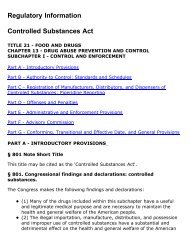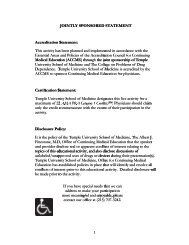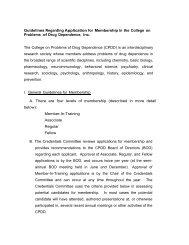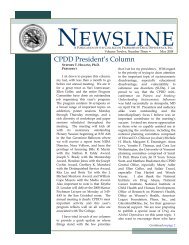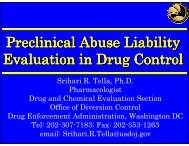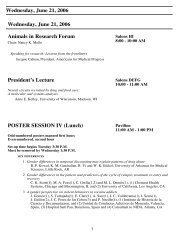CPDD 72nd Annual Meeting • Scottsdale, Arizona - The College on ...
CPDD 72nd Annual Meeting • Scottsdale, Arizona - The College on ...
CPDD 72nd Annual Meeting • Scottsdale, Arizona - The College on ...
You also want an ePaper? Increase the reach of your titles
YUMPU automatically turns print PDFs into web optimized ePapers that Google loves.
141<br />
MORPHINE IN COMBINATION WITH METABOTROPIC<br />
GLUTAMATE RECEPTOR ANTAGONISTS IN A MODEL OF<br />
INFLAMMATORY PAIN.<br />
Dana E Daugherty 1 , M J Picker 1 , L A Dykstra 1,2 ; 1 Psychology, University of<br />
North Carolina at Chapel Hill, Chapel Hill, NC, 2 Pharmacology, University of<br />
North Carolina at Chapel Hill, Chapel Hill, NC<br />
Aims: <str<strong>on</strong>g>The</str<strong>on</strong>g> present study examined the effects of the mGluR1 antag<strong>on</strong>ist [(3,4dihydro-2H-pyrano[2,3-b]quinolin-7-yl)-(cis-4-methoxycyclohexl)-methan<strong>on</strong>e]<br />
(JNJ16259685) and the mGluR5 antag<strong>on</strong>ist 2-methyl-6-(phenyl-ethynyl) pyridine<br />
hydrocholoride (MPEP), al<strong>on</strong>e or in combinati<strong>on</strong> with selected doses of<br />
morphine in the capsaicin-induced hyperalgesic tail withdrawal model of inflammatory<br />
pain in rats.<br />
Methods: Baseline latencies to withdraw the tail from a 45°C water bath were<br />
determined in male Fischer 344 rats following capsaicin admininstrati<strong>on</strong> to the<br />
tail . After baseline determinati<strong>on</strong>s, morphine (0.3-10.0 mg/kg), JNJ16259685<br />
(1.0-3.0 mg/kg), or MPEP (1.0-10.0 mg/kg) were administered al<strong>on</strong>e or in<br />
selected dose combinati<strong>on</strong>s 30 min prior to testing. 15 min prior to testing, rats<br />
received 0.3 μg capsaicin into the tail under isoflurane anesthesia, with animals<br />
recovering within 2-3 min. Latencies to withdraw the tail from the 45°C water<br />
bath were recorded 15 min following capsaicin injecti<strong>on</strong>.<br />
Results: JNJ16259685 produced no significant antinociceptive effect al<strong>on</strong>e and<br />
did not shift the morphine dose effect curve at any dose tested. Similarly, low<br />
doses of MPEP (1.0-3.0 mg/kg) produced no antinociceptive effect al<strong>on</strong>e and<br />
did not shift the morphine dose effect curve; however, the highest dose of MPEP<br />
(10.0 mg/kg) produced a significant antinociceptive effect al<strong>on</strong>e and a small, but<br />
significant attenuati<strong>on</strong> of the high morphine doses (3.0-10.0 mg/kg).<br />
C<strong>on</strong>clusi<strong>on</strong>s: <str<strong>on</strong>g>The</str<strong>on</strong>g>se results indicate that the effects of mGluR antag<strong>on</strong>ism <strong>on</strong><br />
morphine antinocicepti<strong>on</strong> in an inflammatory pain model depend <strong>on</strong> the dose<br />
and type of antag<strong>on</strong>ist as well as the dose of morphine.<br />
Financial Support: R01-DA002749 and T32-DA007244.<br />
143<br />
LOPERAMIDE-INDUCED TASTE AVERSIONS IN F344 AND<br />
LEW RATS: ASSESSMENT OF PERIPHERAL OPIOID<br />
ACTIVATION.<br />
Catherine M Davis 1 , J L Cobuzzi 2 , A L Riley 2 ; 1 Psychiatry and Behavioral<br />
Sciences, Divisi<strong>on</strong> of Behavioral Biology, Johns Hopkins University School of<br />
Medicine, Baltimore, MD, 2 Psychology, American University, Washingt<strong>on</strong>, DC<br />
Aims: <str<strong>on</strong>g>The</str<strong>on</strong>g> inbred F344 and LEW rats display strain differences in the aversive<br />
effects of systemically administered morphine, but display no differences in the<br />
aversive effects of centrally administered DAMGO, a selective mu opioid receptor<br />
ag<strong>on</strong>ist. <str<strong>on</strong>g>The</str<strong>on</strong>g>se discrepant results suggest that the strain differences in morphine’s<br />
aversive effects between these animals could be a functi<strong>on</strong> of differential<br />
activati<strong>on</strong> of peripheral mu opioid receptors.<br />
Methods: To test this hypothesis, male F344 (N = 67) and LEW (N = 67) rats<br />
were c<strong>on</strong>diti<strong>on</strong>ed with loperamide, a peripheral mu opioid receptor ag<strong>on</strong>ist, in<br />
the CTA design. Animals received saccharin to drink followed by an injecti<strong>on</strong> of<br />
loperamide (0, 10, 18 or 32 mg/kg, s.c.; a total of three such pairings).<br />
Results: Repeated-measures ANOVA revealed no strain differences, i.e., loperamide<br />
induced aversi<strong>on</strong>s of comparable strength in LEW and F344 rats, suggesting<br />
that peripheral mu opioid activati<strong>on</strong> does not differ between the two<br />
strains. In follow-up assessments in which rats of both strains received saccharin<br />
without a subsequent loperamide injecti<strong>on</strong>, <strong>on</strong>ly the LEW rats c<strong>on</strong>diti<strong>on</strong>ed<br />
with10 mg/kg loperamide extinguished the CTA; extincti<strong>on</strong> was not evident in<br />
any other group.<br />
C<strong>on</strong>clusi<strong>on</strong>s: <str<strong>on</strong>g>The</str<strong>on</strong>g> fact that loperamide induced dose-dependent aversi<strong>on</strong>s in<br />
both strains with no significant differences in acquisiti<strong>on</strong> of the aversi<strong>on</strong>s suggests<br />
that factors other than peripheral opioid activati<strong>on</strong> accounts for the reported<br />
differences in morphine-induced CTA between the two strains (F>L). One<br />
possibility is that the aversive effects of morphine are peripherally mediated and<br />
similar for the F344 and LEW rats. Morphine’s central (rewarding) acti<strong>on</strong>s may<br />
be different between F344 and LEW rats and it is this central activity that may<br />
modulate morphine’s perceived aversive effects, i.e., the centrally mediated<br />
rewarding effects of morphine may impact the degree to which it can c<strong>on</strong>diti<strong>on</strong><br />
an aversi<strong>on</strong> in the two strains.<br />
Financial Support: Supported by a grant from the Mell<strong>on</strong> Foundati<strong>on</strong> to ALR.<br />
<str<strong>on</strong>g>CPDD</str<strong>on</strong>g> <str<strong>on</strong>g>72nd</str<strong>on</strong>g> <str<strong>on</strong>g>Annual</str<strong>on</strong>g> <str<strong>on</strong>g>Meeting</str<strong>on</strong>g> <str<strong>on</strong>g>•</str<strong>on</strong>g> <str<strong>on</strong>g>Scottsdale</str<strong>on</strong>g>, <str<strong>on</strong>g>Ariz<strong>on</strong>a</str<strong>on</strong>g><br />
36<br />
142<br />
DISTRESS TOLERANCE AND ADOLESCENT SUBSTANCE<br />
USE PROBLEM SEVERITY.<br />
Stacey B Daughters 1 , S M Gorka 1,2 , C W Lejuez 2 , R M Travers 2 , J Le<strong>on</strong>ard 1 , K<br />
Smith 2 ; 1 Department of Public and Community Health, University of<br />
Maryland, <str<strong>on</strong>g>College</str<strong>on</strong>g> Park, MD, 2 Department of Psychology, University of<br />
Maryland, <str<strong>on</strong>g>College</str<strong>on</strong>g> Park, MD<br />
Aims: <str<strong>on</strong>g>The</str<strong>on</strong>g> problem of substance use in adolescence c<strong>on</strong>tinues to grow despite<br />
large-scale public health efforts to reduce both its incidence and prevalence. This<br />
is particularly troublesome given that adolescent substance use and especially<br />
misuse often signals future impairments in physical health, mental health and<br />
social and occupati<strong>on</strong>al functi<strong>on</strong>ing. To enhance preventi<strong>on</strong> efforts, theorists<br />
have attempted to understand factors that c<strong>on</strong>tribute to the etiology and maintenance<br />
of substance misuse, with particular emphasis <strong>on</strong> the role of negative<br />
emoti<strong>on</strong>al states. Initial evidence suggests that pre-adolescents with low distress<br />
tolerance, defined as the inability to persist in goal directed activity in the presence<br />
of intense emoti<strong>on</strong>al discomfort, are significantly more likely to have used<br />
alcohol in the past year (Daughters et al., 2009). However, limitati<strong>on</strong>s of this<br />
study included low levels of past year alcohol use indicative of a pre adolescent<br />
sample, as well as lack of inclusi<strong>on</strong> of a measure of behavioral disinhibiti<strong>on</strong>,<br />
which is c<strong>on</strong>sistently associated with higher rates of delinquent behavior am<strong>on</strong>g<br />
adolescents.<br />
Methods: In attempts to replicate and expand <strong>on</strong> this finding, we examined the<br />
relati<strong>on</strong>ship between distress tolerance, behavioral disinhibiti<strong>on</strong> (i.e., impulsivity),<br />
and the total substance use problem index of the Global Appraisal of Individual<br />
Needs (GAINS) scale am<strong>on</strong>g a sample of 150 15-17 year old adolescents.<br />
Results: Hierarchical linear regressi<strong>on</strong> was used to example the unique and interacting<br />
effects of distress tolerance and impulsivity <strong>on</strong> substance use total problems.<br />
Findings indicate that am<strong>on</strong>g girls, but not boys, the interacti<strong>on</strong> of low distress<br />
tolerance and high levels of impulsivity significantly predict greater<br />
substance use total problems (R2 = .21, F = 6.6, p < .001; B = 0.22, sr2 = .09, p<br />
< .001).<br />
C<strong>on</strong>clusi<strong>on</strong>s: Future research directi<strong>on</strong>s and implicati<strong>on</strong>s for translating this basic<br />
research into effective preventi<strong>on</strong> and interventi<strong>on</strong> programs will be discussed.<br />
Financial Support: NIDA R21DA022741<br />
144<br />
MANUFACTURE, CHARACTERIZATION, AND STABILITY<br />
OF STANDARDIZED MARIJUANA CIGARETTES.<br />
K Davis 1 , Po<strong>on</strong>am G Pande 1 , B Thomas 1 , S Sabharwal 1 , M McCleary 1 , L<br />
Caddell 1 , P Leahy 1 , M ElSohly 2 ; 1 Analytical Chemistry & Pharmaceutics, RTI<br />
Internati<strong>on</strong>al, Research Triangle Park, NC, 2 University of Mississippi,<br />
University, MS<br />
Aims: <str<strong>on</strong>g>The</str<strong>on</strong>g> NIDA Drug Supply Program requires a c<strong>on</strong>stant supply of standardized<br />
marijuana cigarettes at specified potencies for use in scientific research and<br />
clinical studies. <str<strong>on</strong>g>The</str<strong>on</strong>g>se cigarettes are manufactured per current good manufacturing<br />
practices regulati<strong>on</strong>s and released per established specificati<strong>on</strong>s for Δ9-THC<br />
and moisture c<strong>on</strong>tent.<br />
Methods: RTI has been manufacturing marijuana cigarettes for NIDA since<br />
1974. <str<strong>on</strong>g>The</str<strong>on</strong>g> marijuana cigarettes are standardized for size and weight. <str<strong>on</strong>g>The</str<strong>on</strong>g> manufacturing<br />
parameters are kept c<strong>on</strong>sistent between batches. Potency is c<strong>on</strong>trolled<br />
through selective blending of bulk marijuana batches to produce a uniform,<br />
homogeneous lot of starting material for cigarette manufacture. For c<strong>on</strong>trols or<br />
placebos, Δ9-THC is extracted to produce plant material with less than 0.1%<br />
Δ9-THC. During manufacture, the cigarettes are tested for weight variati<strong>on</strong>,<br />
moisture by a gravimetric method, and Δ9-THC c<strong>on</strong>tent by a validated capillary<br />
gas chromatography (CGC) method. Analyses obtained via three extracti<strong>on</strong> procedures<br />
provide profile of the cannabinoid c<strong>on</strong>tent of cigarettes. Stability of cigarettes<br />
is m<strong>on</strong>itored at ambient, refrigerator, and freezer c<strong>on</strong>diti<strong>on</strong>s. At threem<strong>on</strong>th<br />
intervals, the stored cigarettes are analyzed for Δ9–THC and other<br />
cannabinoids by CGC. <str<strong>on</strong>g>The</str<strong>on</strong>g> quantitative analytical data obtained from these<br />
analyses is examined for trends over time. Data for each batch of marijuana cigarettes<br />
is placed in a FDA Drug Master File and included in IND applicati<strong>on</strong>s<br />
by NIDA investigators.<br />
Results: <str<strong>on</strong>g>The</str<strong>on</strong>g> analytical data obtained dem<strong>on</strong>strate that each batch of standardized<br />
marijuana cigarettes meet established specificati<strong>on</strong>s for Δ9-THC and moisture<br />
c<strong>on</strong>tent. <str<strong>on</strong>g>The</str<strong>on</strong>g> cigarettes are found to be stable at frozen c<strong>on</strong>diti<strong>on</strong>s.<br />
C<strong>on</strong>clusi<strong>on</strong>s: Standardized marijuana cigarettes manufactured at varying potencies<br />
as required by NIDA, stored under frozen c<strong>on</strong>diti<strong>on</strong>s and shipped to NIDA<br />
investigators are of appropriate quality for use in research programs.<br />
Financial Support: By NIDA under a c<strong>on</strong>tract to the University of Mississippi<br />
and subc<strong>on</strong>tract to RTI.



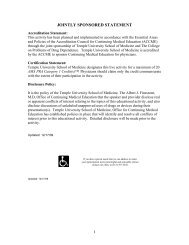
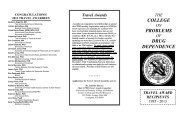
![2013SYMP AND WORKSHOP LIST[web]](https://img.yumpu.com/35325424/1/190x245/2013symp-and-workshop-listweb.jpg?quality=85)
